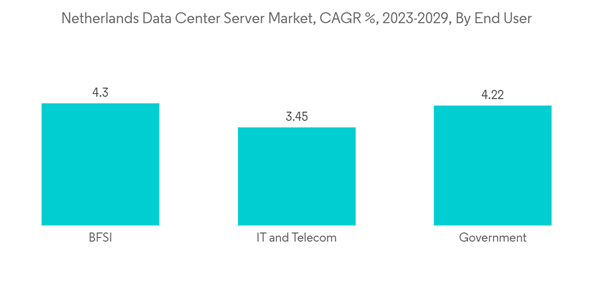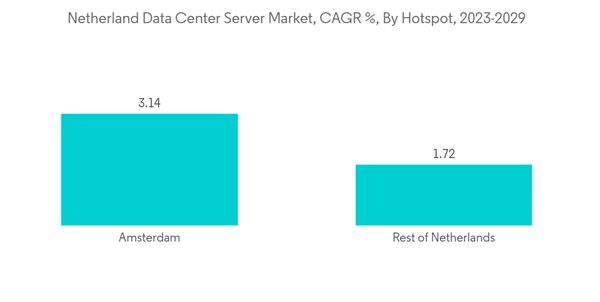Key Highlights
- The upcoming IT load capacity of the Netherlands data center market is expected to reach 1490.2 MW by 2029. The country's construction of raised floor area is expected to increase by 6.7 million sq. ft by 2029.
- The country's total number of racks to be installed is expected to reach 338,134 units by 2029. Amsterdam will likely house the maximum number of racks by 2029.
- There are close to 10 submarine cable systems connecting the Netherlands, and many are under construction. One such submarine cable, built in 2022, is BT North Sea, with landing points in Callantsoog, Netherlands.
Netherland Data Center Server Market Trends
IT and Telecom to Have Significant Market Share
- The cloud segment is expected to contribute the highest market share among end-user industries and witness the fastest growth during the forecast period. The cloud sector is expected to grow at a CAGR of 4.36% to surpass 276.89 MW by 2029.
- Cloud storage in the Netherlands is expanding as a result of rising demand for low-cost data backup, storage, and protection across all companies and the need to manage the data produced by the increased use of mobile technology.
- Over the past ten years, there have been enormous advancements in the public cloud business, and the COVID-19 pandemic served as a significant catalyst. Many people and corporations are now utilizing the cloud because of its dependability. As a result, the cloud segment is expected to hold the highest market share of 24.4% in 2029, followed by BFSI (Banking, Financial Services, and Insurance) and Telecom, with market shares of 12.5% and 11.4%, respectively.
- The National Cloud Policy 2011 needed revision as the reliability and security of public cloud services improved, while patches made it far more manageable than previously to correct software flaws. The new regulation permits the usage of public cloud services by Dutch government agencies.
- With the new legislation, hyperscalers would be able to negotiate new contracts with the government and reputable local cloud providers such as KPN, who provide Azure and AWS services.
- The government is expected to make more investments to innovate in areas such as quantum computing, artificial intelligence, and applications utilizing 5G and 6G technologies. It aims to attain full 5G coverage, for which it has planned a 5G spectrum auction in 2023. Such aspects are expected to complement the growth and demand for data processing facilities in the telecom industry.
Blade Server To Have The Highest Market Share
- The type of server that's designed to be in a data center is blade servers. These servers share a common chassis or enclosure, making them thinner and more compact. Space efficiency, modularity, reduced cable fragmentation, efficient cooling, centralized management, frequency availability, and energy efficiency are some of the main features and benefits of blade servers.
- Single or multiple server blades can be inserted or removed without distressing another running system. It reduces hardware costs, which is likely to entice industry players to adopt the technology, thereby fueling market growth. Additionally, each server blade does not consist of a distinct infrastructure and chassis, owing to which the product is relatively cheaper as compared to other solutions.
- To cater to end-user needs, the top companies are focusing on blade servers in data centers. The prominent companies that manufacture blade servers in the Netherlands include Dell (PowerEdge M Series), HPE (ProLiant BL Series), Cisco (UCS Blade Servers), and Lenovo (ThinkSystem Blade Servers), among others.
- The growing adoption of technologies such as cloud computing, AI, and IT services by businesses is propelling the use of servers in data centers. This sector is driven by the increased demand for streaming solutions and hyperscale data centers. Hyperscale computing, which is considered to be cost-effective in terms of enabling applications for large amounts of data, relies on the highly scalable server architecture and virtual networks that are becoming more and more popular.
- In the future, the growing internet penetration and fiber connectivity will push the country digitally, which could propel the Netherlands' digital economy. For instance, the evolution of healthcare would focus on reengineering clinical care and operations around digital health and the pervasive, real-time use of data and advanced analytics to achieve these goals. Such achievements would require storing a large amount of data, driving the need for data center blade servers over the forecast period.
- Further, the Netherlands' largest data center investment is in Amsterdam, which is also a part of the famous FLAP-D market in Western Europe. It serves as the country's economic and technological hub. With a large number of Dutch and international businesses and institutions and one of the most significant financial centers in Europe, Amsterdam is the country's most significant economic region.
Netherland Data Center Server Industry Overview
The Netherland data center server market is moderately consolidated, with significant companies such as Dell Inc., International Business Machines (IBM) Corporation, Huawei Technologies Co. Ltd., Cisco Systems Inc. and Lenovo Group Limited.Additional Benefits:
- The market estimate (ME) sheet in Excel format
- 3 months of analyst support
This product will be delivered within 2 business days.










